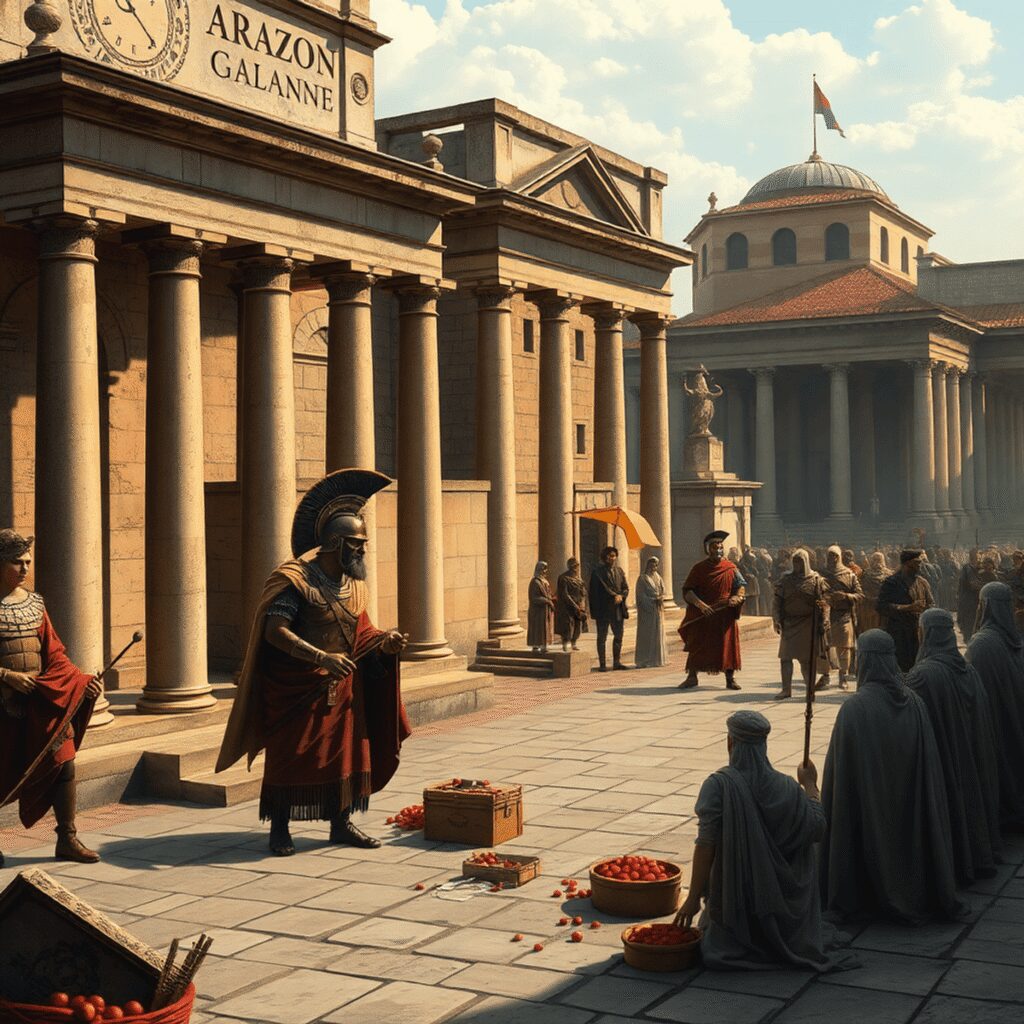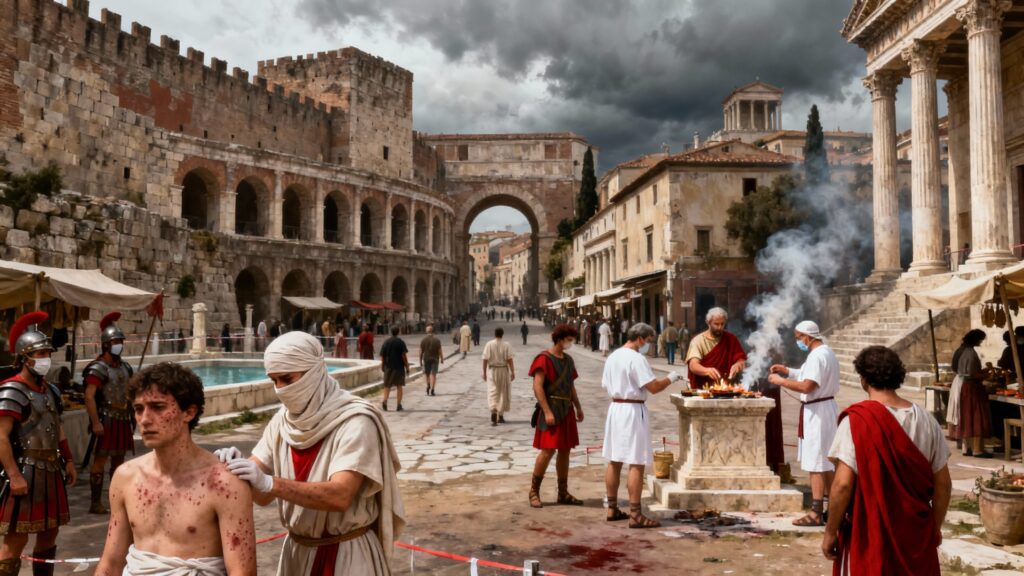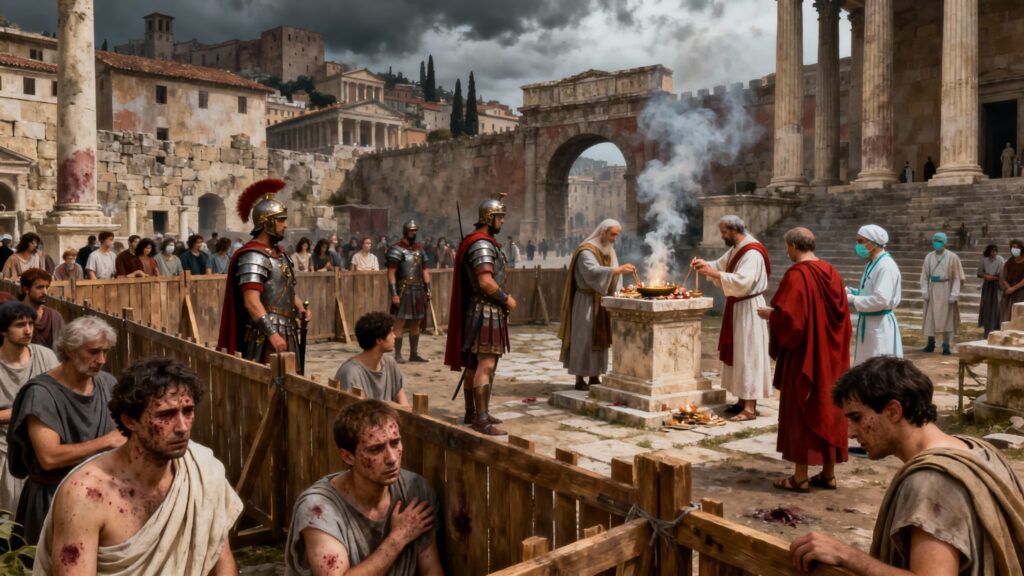Plagues in ancient Rome were devastating events that profoundly affected the population, economy, and social structures. Epidemics such as the Antonine Plague and the Plague of Cyprian caused widespread mortality, disrupting daily life and challenging the Roman authorities. Understanding how Romans confronted these crises reveals early public health efforts long before modern medicine.
How Did Romans Deal with Plagues? Ancient Quarantine Strategies Revealed uncovers the methods employed by this civilization to manage disease outbreaks. While lacking today’s scientific knowledge of germs and transmission, Romans implemented various strategies to control contagion. These included early forms of isolation—separating the sick from healthy individuals—and informal avoidance practices.
However, the Roman response to plagues was not solely based on practical measures. Their approach also involved a significant reliance on rituals and sacrifices, reflecting their deep connection with the divine. The Romans believed that maintaining good relationships with their gods was crucial, especially during times of crisis like a plague.
The Roman approach to plagues combined medical observations with social measures aimed at reducing contact with infected persons. This blend of practical responses laid foundational ideas that would influence later public health developments. Exploring these ancient quarantine strategies offers valuable insight into humanity’s long-standing battle against infectious diseases.
Understanding Plagues in Ancient Rome
Roman plagues had a significant impact on society, shaping public health responses despite limited scientific knowledge. Two of the most devastating epidemics were the Antonine Plague (165–180 AD) and the Plague of Cyprian (249–262 AD).
The Antonine Plague
The Antonine Plague, likely smallpox or measles, caused widespread mortality among soldiers and civilians alike.
The Plague of Cyprian
The Plague of Cyprian, named after the Christian bishop who described it, presented with severe symptoms including fever, diarrhea, and skin eruptions.
Disease Recognition in Ancient Rome
Romans identified these diseases mainly through observable symptoms rather than an understanding of germs or contagion. Physicians and chroniclers recorded visible signs:
- High fever
- Skin lesions or rashes
- Respiratory distress
- Gastrointestinal upset
Symptom descriptions from sources like Galen helped communities recognize when a plague was present. Despite this recognition, Romans lacked knowledge about how diseases spread. They did not understand airborne transmission or vectors like rats and fleas but noticed that proximity to the sick often led to illness.
Disease recognition was largely practical and symptom-based. This awareness formed the foundation for later efforts to isolate affected individuals to limit contact with healthy populations. Recognizing patterns in illness was crucial in a time without microscopes or modern epidemiology tools.

Political and Economic Impact of Plagues
However, the impact of these plagues extended beyond just health concerns; they also worsened existing political instability and weak leadership, contributing to the crumbling foundation of Rome during that period. This decline was not merely due to external invasions but rather a complex interplay of internal strife and ineffective governance.
Additionally, the economic consequences of such widespread disease were profound. The trade and economy in ancient Rome were foundational to its vast empire, influencing both daily life and long-term stability. Understanding these intricate systems reveals the significance of economic practices that shaped one of history’s most powerful civilizations.
Cultural Resilience Amidst Crisis
While dealing with these plagues, Romans continued to rely on their rich cultural heritage, including their religious beliefs, which provided comfort and hope during such turbulent times. The Roman Pantheon is a diverse collection of gods and goddesses worshipped in ancient Rome, reflecting the values, beliefs, and customs that influenced the lives of its people.
Early Isolation Practices in Roman Society
Isolation served as one of the earliest tools for disease control in ancient Rome, especially concerning illnesses heavily burdened by social discrimination. Leprosy stands out as a primary example. Those afflicted were often forcibly removed from their communities and compelled to live apart, reflecting both a rudimentary understanding of contagion and deep-seated societal fears.
Key aspects of Roman isolation practices included:
- Designated living areas: Individuals with leprosy or other visibly disfiguring diseases were confined to specific zones outside city limits.
- Legal restrictions: Laws sometimes mandated physical separation, reinforcing social divisions and stigmatization.
- Religious and moral judgments: Disease was frequently interpreted as divine punishment, increasing marginalization of the sick.
Challenges arose in balancing public health concerns with the humanity of isolated individuals. Separation often led to:
- Emotional and psychological trauma due to exclusion.
- Economic hardship caused by loss of work and social support.
- Heightened stigma that reinforced negative stereotypes about certain diseases.
Romans struggled to integrate isolation measures without exacerbating social inequalities. The tension between protecting public health and avoiding harsh discrimination shaped early approaches to managing contagious diseases. Understanding these dynamics sheds light on how ancient societies grappled with the complex human realities behind epidemic control.
Interestingly, these isolation practices were not just limited to health issues; they also extended into the realm of political power and propaganda. For instance, coins were used as powerful tools by emperors to convey their authority and legitimacy. These small pieces of currency went beyond their basic purpose and became significant instruments for political messaging.
Furthermore, the evolution of Roman sculpture, which reflected the cultural, political, and social dynamics of ancient Rome, also played a role in this narrative. This art form evolved significantly over time, showcasing a distinct focus on realism and the portrayal of power. The sculptures served not only as artistic expressions but also as instruments for political propaganda and religious devotion.

Primitive Containment Measures Without Formal Quarantine
Romans relied heavily on containment through avoidance strategies rather than formalized quarantine systems. Their approach to managing plagues lacked official protocols but involved practical steps aimed at reducing exposure to the sick.
Key informal practices included:
- Avoiding neighborhoods known to harbor illness: Certain districts or homes where diseases had broken out were commonly shunned by healthy citizens. People steered clear of these areas to minimize contact with potential sources of infection.
- Social distancing from visibly ill individuals: Roman society recognized symptoms such as fever, rash, or coughing and often ostracized those showing signs of disease. This social exclusion acted as a rudimentary barrier against contagion.
- Limiting public gatherings during outbreaks: While not systematically enforced, there was a general tendency to reduce participation in crowded events, marketplaces, or baths when plagues spread.
- Use of personal protective behaviors: Though primitive by modern standards, some Romans employed masks or veils to cover their faces when near the sick, reflecting an early awareness of transmission risks.
These containment efforts were shaped by observation and experience rather than scientific understanding. The Romans’ focus on avoiding contact with the ill shows an intuitive grasp of disease spread despite lacking formal quarantine measures.
The Role of Physicians like Galen in Plague Management
Roman physicians played a crucial role in shaping the medical response during plague outbreaks, with Galen standing out as one of the most influential figures. His detailed medical observations on symptoms and disease progression became essential references for understanding epidemics in antiquity.
Galen’s Contributions:
- Systematic documentation of plague symptoms such as fever, skin eruptions, respiratory distress, and gastrointestinal issues.
- Advice on treatments based on humoral theory, including bloodletting and herbal remedies aimed at restoring bodily balance.
- Emphasis on patient care and hygiene practices to mitigate suffering.
Despite his comprehensive work, Galen and his contemporaries faced significant limitations. The concept of contagion was not fully developed; they lacked knowledge about pathogens or mechanisms of disease transmission. Illnesses were often attributed to imbalances in bodily humors or environmental factors like miasma (bad air). This gap influenced public health responses since isolation was more reactive than preventive.
Physicians could identify symptoms but struggled to enforce or recommend effective containment measures. Their focus remained largely clinical rather than epidemiological. The absence of germ theory meant that strategies such as quarantine were not formalized or widely implemented based on medical advice alone.
Galen’s legacy lies in the advancement of medical knowledge through empirical observation, laying groundwork for future generations despite the era’s scientific constraints.
From Roman Practices to Medieval Quarantine Systems
The Romans mainly used informal methods like isolation and avoidance to deal with plagues, without having a formal system for public health enforcement. Their approach was centered around separating sick individuals who showed visible signs of illness, especially those with socially stigmatized diseases such as leprosy. However, this method did not include people who were asymptomatic or had been exposed to the disease. It somewhat mirrored the broader power and strategy of the Roman military, which operated as a well-organized machine combining discipline, strategy, and innovation.
The Evolution of Disease Control: Medieval Quarantine Systems
Medieval quarantine systems represented a significant advancement in controlling diseases. The word quarantine comes from the Italian term quaranta giorni, meaning “forty days,” which refers to the isolation period enforced during plague outbreaks. This practice emerged from observations that acute illnesses typically appeared within approximately 40 days after exposure.
Key early examples of structured quarantine include:
- Ragusa (modern Dubrovnik), 1377: Implemented a mandatory 30-day isolation for ships and 40 days for land travelers arriving from plague-affected regions. This was one of the earliest official attempts to prevent disease introduction through enforced separation.
- Venice, 1423: Established the first lazaretto, a dedicated quarantine station on an island near the city. This facility served as a model for other ports and incorporated systematic screening and detention of potentially infected individuals before they could enter the city, marking a significant evolution in the history of lazarettos.
These medieval measures introduced important distinctions:
- Separation of healthy individuals potentially exposed to disease (quarantine), distinct from isolating confirmed cases (isolation).
- Legal enforcement of health regulations to control movement and contact.
This transition reflected an increased understanding that controlling epidemic spread required managing not only the visibly ill but also those who might carry infection without symptoms. Such advancements in public health strategies can be seen as a precursor to modern practices, highlighting an evolution in our understanding and management of diseases as discussed in various studies on the historical context of quarantine.

Comparing Roman and Medieval Approaches to Disease Control
The contrast between Roman vs medieval quarantine methods reveals a shift from informal isolation practices to formalized public health strategies.
1. Informal vs Systematic
Romans primarily used isolation on an individual basis, focusing on visibly sick people, especially those with stigmatized diseases like leprosy. Isolation was reactive and socially driven rather than medically enforced. In contrast, medieval Europe developed quarantine as a proactive measure, targeting not only the sick but also those potentially exposed but asymptomatic. This represented a move toward controlling disease spread before symptoms appeared.
2. Duration and Standardization
Roman isolation lacked a fixed duration. Decisions were often based on social status or visible symptoms. Medieval quarantine introduced standardized isolation periods—most notably the 40-day “quaranta giorni“—rooted in observations of disease incubation times. This provided consistency and predictability absent in Roman practices.
3. Institutional Support
Roman efforts were decentralized, relying on families and local communities to separate the ill. Medieval cities like Ragusa and Venice created dedicated quarantine stations (lazarettos), supported by official regulations and enforcement mechanisms.
4. Understanding of Contagion
Romans recognized plagues but misunderstood transmission, leading to avoidance behaviors without clear scientific rationale. Medieval approaches began incorporating empirical observations into public health policies, even if germ theory was still centuries away.
These distinctions highlight how ancient Rome laid groundwork through early isolation, while medieval Europe built upon it by formalizing quarantine systems critical for future epidemic management.
Legacy of Ancient Strategies in Modern Public Health
The influence of ancient practices on today’s quarantine measures is often underestimated. The Roman approach to disease control, although basic and lacking scientific understanding of how diseases spread, introduced important concepts such as isolating the sick and avoiding contact with infected individuals. These ideas laid the foundation for future advancements in public health practices.
Lessons from History
Historical perspectives provide valuable lessons that inform how we handle modern epidemics:
- Understanding social dynamics around disease stigma, as seen with leprosy isolation
- Recognizing incubation periods influencing quarantine duration, inspired by ancient observations
- Balancing public safety with individual rights, a challenge first faced by Roman society
Continuation of Ancient Practices
The practice of isolating individuals showing symptoms or known to carry contagious diseases strongly resonates with today’s quarantine protocols. Romans observed that restricting movement and contact helped reduce disease spread, even if they didn’t fully understand the biological mechanisms behind transmission. This observation became a fundamental principle in designing effective responses to epidemics.
Modern public health continues to draw on these ancient experiences to craft policies that minimize outbreaks while addressing societal impacts. The persistence of quarantine as a vital tool demonstrates how early strategies have transcended time, adapting with advances in medical knowledge but retaining their core principles rooted in antiquity.
This enduring legacy is not only limited to public health but also extends to various aspects of contemporary society:
- Our legal systems
- Artistic traditions, including masterpieces of Roman art
These examples showcase the profound impact of Roman civilization on Western culture.
Conclusion
The story of How Did Romans Deal with Plagues? Ancient Quarantine Strategies Revealed highlights the roots of epidemic management in Roman society. The Romans, despite limited scientific knowledge, developed early isolation and containment practices that laid groundwork for later advances in public health. Their responses to plagues demonstrate practical attempts to curb disease spread through social and medical means.
Understanding these ancient strategies provides valuable insights into the evolution of plague management. It shows how observation, social behavior, and emerging medical advice combined to shape early disease control efforts. These lessons remain relevant as modern societies continue to confront epidemics and refine quarantine protocols.
You are encouraged to delve deeper into the rich history of public health measures. Exploring how past civilizations like the Romans faced similar challenges can enrich your perspective on today’s epidemic responses and inspire innovative approaches for the future.
FAQs (Frequently Asked Questions)
How did ancient Romans recognize and respond to plagues despite limited medical knowledge?
Ancient Romans identified common plagues such as the Antonine Plague and the Plague of Cyprian by observing symptoms and disease patterns. Although their understanding of disease transmission was limited, they documented symptoms carefully and employed early forms of isolation to manage outbreaks.
What early isolation practices did Romans use to control the spread of diseases?
Romans practiced isolation by separating individuals with socially stigmatized conditions like leprosy from the healthy population. This early form of quarantine aimed to limit contagion but also led to social discrimination and challenges in enforcing these measures.
Did the Romans have formal quarantine systems similar to those in medieval Europe?
No, Roman disease control largely relied on informal containment and avoidance strategies, such as steering clear of affected neighborhoods or individuals. Formal quarantine systems developed later during the medieval period in places like Ragusa and Venice.
What role did physicians like Galen play in managing plagues in ancient Rome?
Prominent Roman physicians such as Galen contributed by documenting plague symptoms and providing medical advice during epidemics. However, their limited understanding of contagion influenced the effectiveness of public health responses at the time.
How did Roman plague management strategies influence medieval quarantine practices?
Roman informal isolation methods laid foundational concepts for disease control that evolved into more systematic quarantine systems during medieval Europe. The transition marked a shift from ad hoc avoidance to structured public health measures.
What is the legacy of ancient Roman plague strategies in modern public health?
Ancient Roman practices have shaped contemporary approaches to disease control, including quarantine measures. Understanding these historical strategies provides valuable insights that continue to inform responses to modern epidemics and public health challenges.

